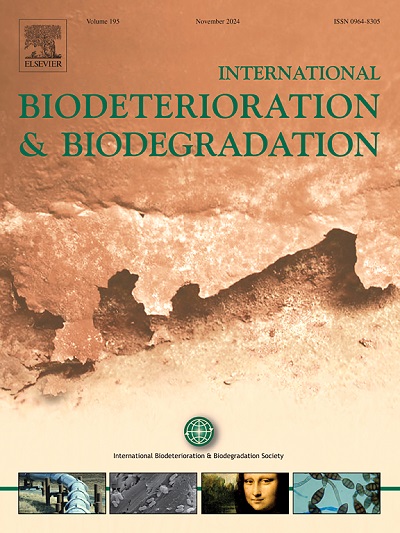丝瓜固定化:对摩尔假单胞菌KB4代谢活性和对乙酰氨基酚降解的影响
IF 4.1
2区 环境科学与生态学
Q2 BIOTECHNOLOGY & APPLIED MICROBIOLOGY
International Biodeterioration & Biodegradation
Pub Date : 2025-02-01
DOI:10.1016/j.ibiod.2025.106007
引用次数: 0
摘要
摩尔假单胞菌KB4属于对乙酰氨基酚降解菌株。将该菌株固定在生物可降解载体——丝瓜纤维素海绵上。本研究旨在确定固定化过程对菌株代谢活性的影响,包括对扑热息痛的生物降解过程。所进行的研究表明,在选定基因的转录水平以及代谢谱和总脂肪酸组成方面存在显著差异。然而,固定过程对扑热息痛的降解没有显著影响。这表明在底物的可用性方面缺乏限制,这对被测菌株没有很大的毒性。然而,固定化会使菌株对有毒的4-氨基酚产生更大的抗性。固定后,可以分解高浓度的扑热息痛,这在正常情况下会导致4-氨基酚的积累,抑制自由菌株的生长。根据剂量的不同,观察到游离细胞和固定细胞对这种药物的降解差异。通过分析对乙酰氨基酚降解途径的酶和中间体,发现游离菌株和固定化菌株对该化合物的代谢存在差异。结果表明,3-甲基-3-乙烯基环己酮是游离菌株KB4降解扑热息痛过程中鉴定出的特征中间体。此外,在固定KB4的体系中,脱氨酶和对苯二酚1,2-双加氧酶没有活性。得到的对苯二酚环可能在固定体系中没有被劈裂。因此,分解可能是通过儿茶酚裂解进行的。本文章由计算机程序翻译,如有差异,请以英文原文为准。
Luffa cylindrica-based immobilization: Effects on metabolic activity and paracetamol degradation by Pseudomonas moorei KB4
Pseudomonas moorei KB4 belongs to the paracetamol-degrading strains. This strain was immobilized on a biodegradable carrier – a cellulose sponge from Luffa cylindrica. The study aimed to determine the impact of the immobilization process on the metabolic activity of the strain, including the biodegradation process of paracetamol. The research that was conducted showed significant differences in the level of transcription of selected genes, as well as in the metabolic profile and the composition of total fatty acids. However, the immobilization process did not significantly affect the degradation of paracetamol. This indicates a lack of limitation in the availability of the substrate, which is not very toxic to the tested strain. However, immobilization causes greater strain resistance to the appearance of the toxic 4-aminophenol. After immobilization, it is possible to decompose higher concentrations of paracetamol, which, under normal conditions, leads to the accumulation of 4-aminophenol, inhibiting the free strain's growth. Differences in the degradation of this drug by free and immobilized cells, depending on the number of doses, were observed. After analyzing the enzymes and intermediates of the paracetamol degradation pathway, differences were shown between the metabolism of this compound by the free and immobilized strain. It was shown that, 3-methyl-3-vinyl-cyclohexanon was a characteristic intermediate identified only during paracetamol degradation by the free strain of KB4. Moreover, no deaminase and hydroquinone 1,2-dioxygenase were active in the system with immobilized KB4. The resulting hydroquinone ring was probably not cleaved in the immobilized system. Hence, decomposition probably proceeds by catechol cleavage.
求助全文
通过发布文献求助,成功后即可免费获取论文全文。
去求助
来源期刊
CiteScore
9.60
自引率
10.40%
发文量
107
审稿时长
21 days
期刊介绍:
International Biodeterioration and Biodegradation publishes original research papers and reviews on the biological causes of deterioration or degradation.

 求助内容:
求助内容: 应助结果提醒方式:
应助结果提醒方式:


